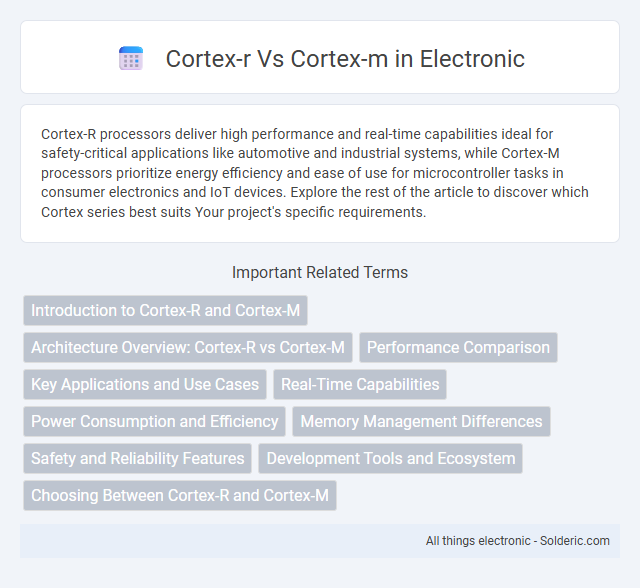Cortex-R processors deliver high performance and real-time capabilities ideal for safety-critical applications like automotive and industrial systems, while Cortex-M processors prioritize energy efficiency and ease of use for microcontroller tasks in consumer electronics and IoT devices. Explore the rest of the article to discover which Cortex series best suits Your project's specific requirements.
Comparison Table
| Feature | Cortex-R | Cortex-M |
|---|---|---|
| Primary Use | Real-time applications, safety-critical systems, automotive | General-purpose microcontrollers, embedded systems |
| Performance | High-performance, deterministic response | Lower power, efficient for control tasks |
| Real-Time Capabilities | Advanced real-time support, predictable behavior | Basic real-time features, suitable for less critical tasks |
| Memory Protection | Supports Memory Protection Unit (MPU) and Error Correction Code (ECC) | Typically includes MPU, no ECC |
| Instruction Set | ARMv7-R, ARMv8-R architecture | ARMv6-M, ARMv7-M, ARMv8-M architecture |
| Interrupt Handling | Low-latency interrupts, advanced priority system | Nested Vectored Interrupt Controller (NVIC) |
| Typical Applications | Automotive ECUs, hard disk drives, medical devices | IoT devices, wearables, consumer electronics |
| Power Consumption | Higher power, optimized for performance and safety | Low power, optimized for battery life |
Introduction to Cortex-R and Cortex-M
Cortex-R processors are designed for real-time applications requiring high reliability and error correction, such as automotive safety and industrial control systems, featuring hardware fault tolerance and low-latency interrupt handling. Cortex-M processors target cost-sensitive, energy-efficient microcontroller applications like IoT devices and consumer electronics, optimized for deterministic performance and ease of use with a simplified instruction set. Both processor families leverage ARM's architecture but serve distinct market segments with differing priorities in performance, safety, and power consumption.
Architecture Overview: Cortex-R vs Cortex-M
Cortex-R processors are designed for real-time applications requiring high reliability and deterministic performance, featuring a Harvard architecture with separate instruction and data caches to minimize latency. In contrast, Cortex-M processors adopt a streamlined von Neumann architecture optimized for low power consumption and efficient interrupt handling in embedded systems. Your choice depends on whether you prioritize real-time response and fault tolerance (Cortex-R) or energy efficiency and ease of use in microcontroller environments (Cortex-M).
Performance Comparison
Cortex-R processors deliver higher real-time performance with deterministic response times, making them ideal for safety-critical applications such as automotive and industrial control. Cortex-M cores emphasize energy efficiency and cost-effectiveness, optimizing performance for low-power embedded systems like IoT devices and wearables. Your choice depends on whether you prioritize faster, reliable processing or power-efficient operation in your embedded design.
Key Applications and Use Cases
Cortex-R processors are optimized for real-time applications requiring high reliability and fault tolerance, making them ideal for automotive systems, industrial control, and safety-critical environments such as medical devices and aerospace. Cortex-M processors excel in low-power, cost-sensitive applications including embedded systems, IoT devices, wearable technology, and consumer electronics. The Cortex-R series supports high-performance control and error correction, while Cortex-M focuses on energy efficiency and ease of integration in microcontroller-based designs.
Real-Time Capabilities
Cortex-R processors deliver enhanced real-time capabilities through features like deterministic interrupt latency, error correction code (ECC) memory support, and tightly coupled memory (TCM) for predictable access. Cortex-M processors excel in low-latency interrupt handling and simplified exception models, making them suitable for time-sensitive control applications. Cortex-R cores prioritize reliability and fault tolerance, essential for automotive and industrial real-time systems, whereas Cortex-M cores target cost-effective, energy-efficient real-time tasks in embedded systems.
Power Consumption and Efficiency
Cortex-R processors are designed for real-time applications with high reliability and performance, leading to higher power consumption compared to Cortex-M processors, which are optimized for low-power, energy-efficient operation in microcontroller environments. The Cortex-M series employs advanced power-saving modes and simplified architectures to maximize energy efficiency, making it ideal for battery-powered and embedded IoT devices. Cortex-R devices strike a balance between processing power and reliability but consume more energy due to features supporting fault tolerance and deterministic response times.
Memory Management Differences
Cortex-R processors feature a Memory Protection Unit (MPU) and support for Error Correcting Code (ECC) memory, enabling robust real-time applications with high reliability and fault tolerance. Cortex-M processors typically include an MPU without ECC support, optimizing them for low-power, cost-sensitive embedded systems where simplified memory management suffices. Your choice between Cortex-R and Cortex-M depends on the criticality of memory protection and error correction needed for your application.
Safety and Reliability Features
Cortex-R processors are designed with advanced safety and reliability features such as lock-step cores, error correction code (ECC) on memories, and fault-tolerant architecture, making them ideal for real-time and safety-critical applications like automotive and industrial control systems. Cortex-M processors prioritize low power consumption and cost efficiency with basic safety features, commonly used in embedded and IoT devices where stringent safety standards are less critical. The robust error detection and correction mechanisms in Cortex-R enhance system dependability, whereas Cortex-M's safety features typically focus on enabling basic error reporting and fault handling.
Development Tools and Ecosystem
Cortex-R processors benefit from a robust ecosystem tailored for real-time and safety-critical applications, featuring specialized development tools like ARM DS-5 and Green Hills MULTI for deterministic performance analysis. Cortex-M's development environment is more extensive, supported by widespread toolchains including Keil MDK, IAR Embedded Workbench, and open-source platforms like ARM GCC, enabling rapid prototyping for embedded applications. Your choice between Cortex-R and Cortex-M influences the available debugging, profiling, and real-time operating system support, which is crucial for optimizing development workflows.
Choosing Between Cortex-R and Cortex-M
Choosing between Cortex-R and Cortex-M cores depends on your application's requirements for performance and reliability. Cortex-R processors excel in real-time, safety-critical systems like automotive and industrial control, offering error correction and high-speed processing. Cortex-M cores are optimized for low-power, cost-sensitive embedded applications such as IoT devices and consumer electronics, providing efficient interrupt handling and ease of integration.
cortex-r vs cortex-m Infographic

 solderic.com
solderic.com